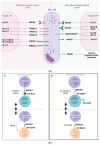Immunomodulatory Activity of the Tyrosine Kinase Inhibitor Dasatinib to Elicit NK Cytotoxicity against Cancer, HIV Infection and Aging
- PMID: 36986778
- PMCID: PMC10055786
- DOI: 10.3390/pharmaceutics15030917
Immunomodulatory Activity of the Tyrosine Kinase Inhibitor Dasatinib to Elicit NK Cytotoxicity against Cancer, HIV Infection and Aging
Abstract
Tyrosine kinase inhibitors (TKIs) have been extensively used as a treatment for chronic myeloid leukemia (CML). Dasatinib is a broad-spectrum TKI with off-target effects that give it an immunomodulatory capacity resulting in increased innate immune responses against cancerous cells and viral infected cells. Several studies reported that dasatinib expanded memory-like natural killer (NK) cells and γδ T cells that have been related with increased control of CML after treatment withdrawal. In the HIV infection setting, these innate cells are associated with virus control and protection, suggesting that dasatinib could have a potential role in improving both the CML and HIV outcomes. Moreover, dasatinib could also directly induce apoptosis of senescence cells, being a new potential senolytic drug. Here, we review in depth the current knowledge of virological and immunogenetic factors associated with the development of powerful cytotoxic responses associated with this drug. Besides, we will discuss the potential therapeutic role against CML, HIV infection and aging.
Keywords: CML; CMV; HIV functional cure; HIV-1; anti-aging; cancer; dasatinib; memory-like NK cells; senolytic; tyrosine kinase inhibitors; γδ T cells.
Conflict of interest statement
The authors declare that the research was conducted in the absence of any commercial or financial relationships that could be construed as a potential conflict of interest.
Figures




References
Publication types
LinkOut - more resources
Full Text Sources

